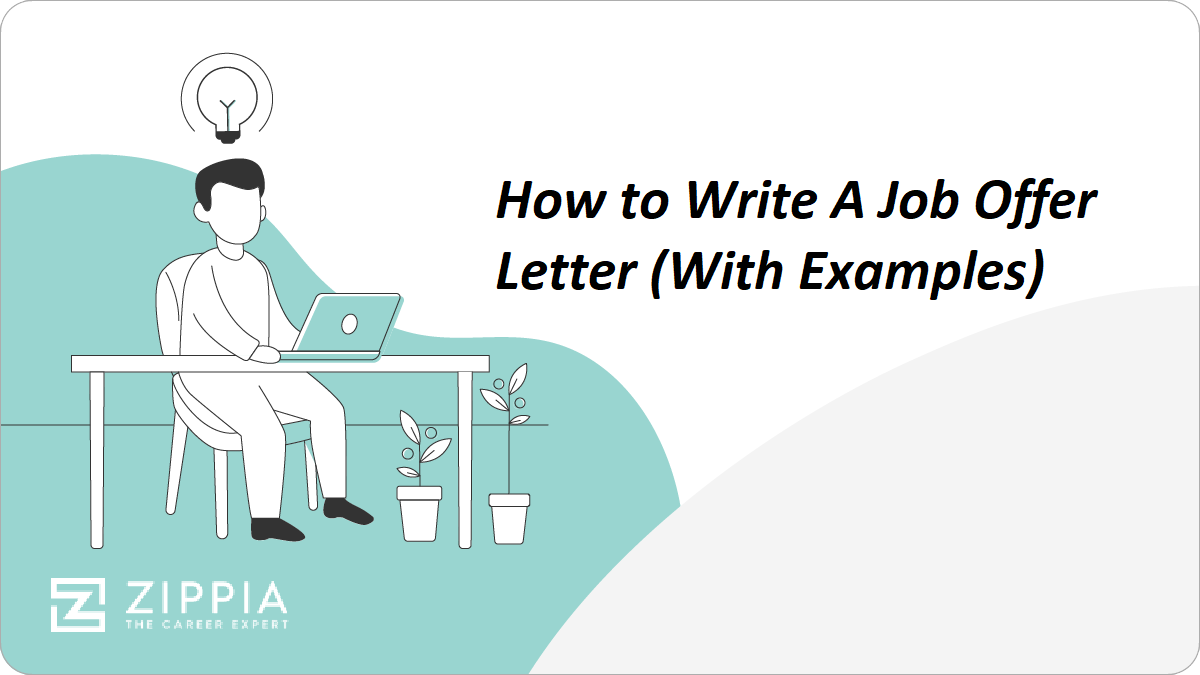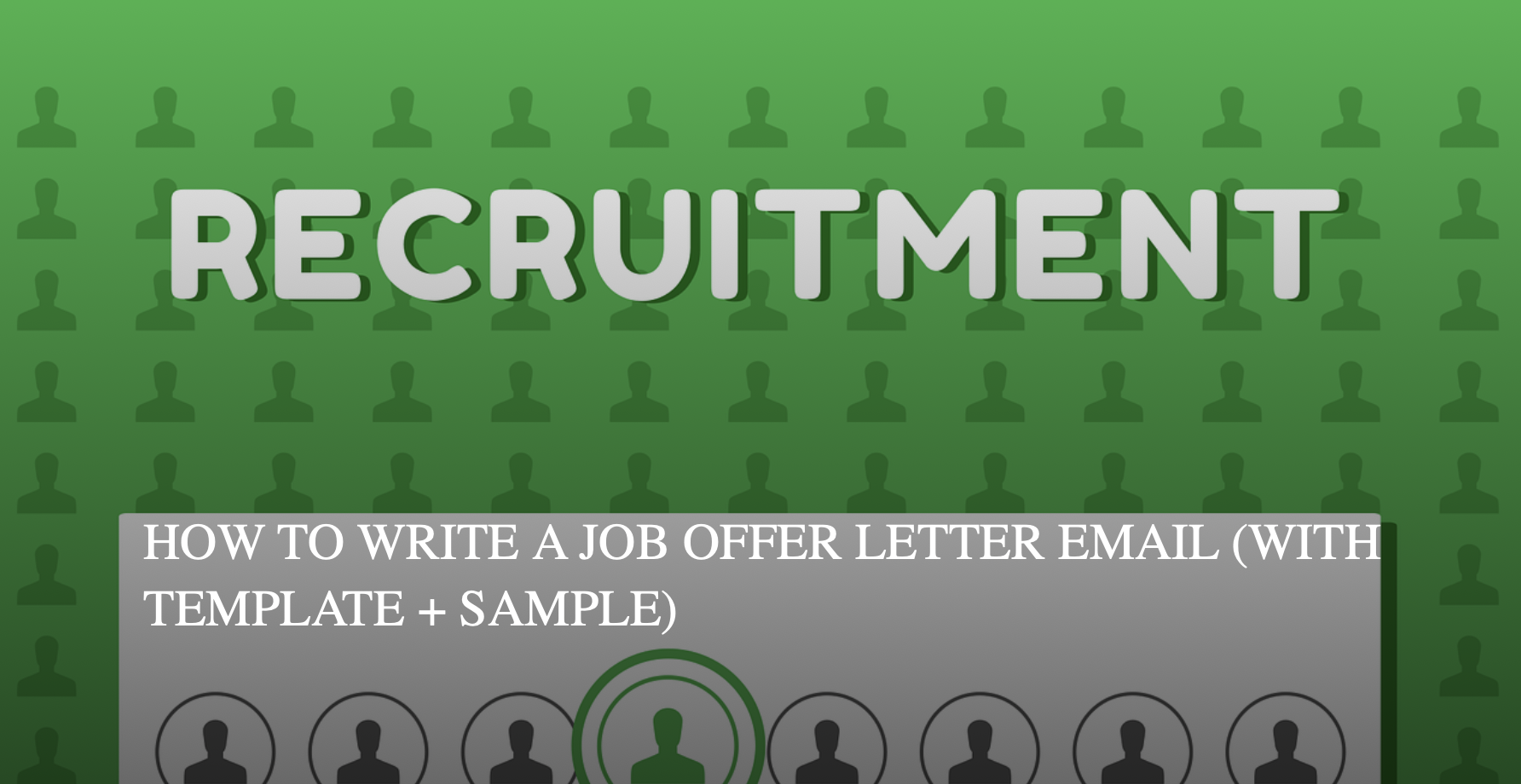By clicking Download, you agree to Zippia’s Privacy Policy and Terms of Use.

Summary. To write a job offer letter, make sure you gather the necessary information first such as the applicants full name, the job title, and any contingencies to their employment. The letter can also include information on their benefits, their salary, or any company policies. Make sure the letter is brief and only include any of the company requirements.
Hiring an employee is an exciting – and exhausting – task. After you’ve completed the interview process and selected a candidate, it may seem like your work is done, but you still need to write an offer letter. While this isn’t nearly as draining as conducting hours of interviews, it still takes some work and is important to do well.
In this article, you’ll learn how to write a job offer letter and find some example templates you can use to write your own.
Key Takeaways:
-
Include all the necessary details in your offer letter and check with HR to make sure you have them all.
-
Mention that the job offer does have some contingencies and isn’t an employment contract.
-
Give the candidate clear next steps as far as asking questions, completing paperwork, and accepting the offer.

How to Write a Job Offer Letter
When you’re putting together a job offer for a potential employee, following these steps will help you write a comprehensive and professional document.
-
Gather the necessary information. Before you can write a thorough job offer, you’ll need to spend some time figuring out the details of what goes into it. Make sure you have:
-
The applicant’s full name (correctly spelled)
-
Their job title
-
Their starting date
-
Their salary
-
Any contingencies to their employment (background checks, drug tests, etc.)
-
Termination conditions/at-will hiring policy
Depending on the job and your company’s policies and styles, you may also want to include:
-
Their schedule/weekly hours
-
Information about any remote or flexible work opportunities
-
Information about their benefits
-
Their job description
-
The name of their manager or supervisor
-
Where they’re going to be working
-
Information about future bonuses or raises
-
Vacation and PTO policies
-
Company privacy policies
-
The expiration date for the offer letter
-
Information about their exempt or non-exempt status
If you aren’t the one who makes the policies for offer letters, make sure you check with your HR department to make sure you haven’t over- or under-shared. While offer letters aren’t necessarily legal documents, it’s important to get them right to avoid costly misunderstandings.
-
-
Draft the letter. You likely will need a few passes over your offer letter to make sure it’s polished and thorough, so don’t put too much pressure on yourself as you write your first draft.
While your letter’s structure will depend on your company and the particular job you’re offering, here are the basic elements of any offer letter:
-
The greeting. “Dear” followed by the candidate’s full name will suffice for this.
-
The purpose of your letter. Don’t beat around the bush – you should state that you’re offering the candidate the job in the first line or two of your letter. Don’t forget to include the job title too.
-
The body paragraphs. This is where you’ll include all the necessary information about the position. Some companies like to put this in paragraph form, while others use bullet points or a combination of both.
-
The closing. Finish by clearly explaining the candidate’s next steps. This should include when you need them to give you an answer and the contact information for the person they can reach out to with questions or accept the offer.
-
The signature. “Sincerely” is always a good way to sign off on a professional letter, but if you know the person, “Best” can also be appropriate. Either way, include your name, job title, and any other required signatures.
-
-
Edit, edit, edit. While you shouldn’t show your offer letter draft to your whole team, have at least one other person look it over before you send it out – ideally, someone who knows what they’re doing when it comes to offer letters or at least the hiring process for this position.
This person can make sure there aren’t any confusing parts, glaring errors, or incorrect information in the letter. This not only will help protect you from embarrassment but also complications arising from incorrect or incomplete information.
Job Offer Letter Templates
-
Standard Offer Letter
Dear [Applicant Name],
We at [Company Name] are pleased to offer you the position of [job title] starting [start date]. We were very impressed with you and your work experience, and we’re excited to have you join our team.
This offer is contingent upon your [passing a drug test, background check, etc.]. In addition, please note that [Company Name] is an at-will employer, which means either you or the company may end your employment at any point, with or without cause or notice.
As [job title], you’ll be expected to work full-time, which is considered [number of hours] hours a week. Working hours are [working hours and days].
You’ll report to [manager or supervisor name and title], and your starting salary will be [salary per hour/year], paid to you biweekly starting [first payment date]. In addition, you’ll be eligible to receive [bonuses, raises, etc.].
You’ll also receive health benefits, vacation, and other benefits as outlined in the attached document.
Please confirm your acceptance of this offer by reaching out to [name] at [contact information] by [date]. If you have any questions, please don’t hesitate to ask those as well.
We look forward to having you join the team!
Sincerely,
[Your Signature][Your Name]
[Your Job Title] -
Simple Job Offer Letter Template
Dear [Candidate Name],
I’m pleased to give you the following employment offer on behalf of [Company Name].
Position: [Job Title]
Start date: [Date]
Salary: [Dollar amount per hour/year]We were very impressed with your work history and skills, and we’re looking forward to having you join our team. Please note that this offer is contingent upon the successful completion of [forms such as I-9, drug test, background check, etc.].
Also, note that [Company Name] is an at-will employer, which means you or the company can terminate your employment at any time, with or without cause or notice. This letter is not a contract of employment.
Please respond with your acceptance or rejection by [date], and if you have any questions in the meantime, please feel free to reach out to [name] at [contact information].
We look forward to hearing from you.
Sincerely,
[Your Signature][Your Name]
[Your Job Title] -
Casual Job Offer Letter Template
Dear [Candidate Name],
We at [Company Name] enjoyed getting to talk with you at your interview, and we were very impressed with your professional expertise and experience. We think you’d be a valuable asset to the company, so we’d like to offer you the position of [title] starting [start date].
In this role, you’d report to [supervisor name and title] and would be responsible for [brief overview of job responsibilities]. You’d start out earning [pay amount per hour/year], paid [biweekly/weekly/monthly] starting [date of the first paycheck], and you’d be able to earn [bonuses or raises] in the future.
You’ll also receive health benefits, [hour or day amount] of paid vacation, and a variety of other awesome perks – including free coffee and snacks – as outlined in the attached document.
As [job title], you’d be working at [company location] [number of hours] a week between the hours of [hours], [days of week].
Please note that this isn’t an employment contract, and [Company Name] is an at-will employer, which means you or the company can end your employment at any time and for any reason.
We are so excited to have you on our team. We’d love to hear your response to this offer by [date], but we know you probably have some questions, so please feel free to reach out to [Name] at [contact information] at any point.
Best,
[Your Signature][Your Name]
[Your Job Title] -
Internal Job Offer Letter Template
Dear [Employee Name],
As we’ve previously discussed, we’re excited to officially offer you a promotion to [position title] starting [start date].
You’ll be paid [dollar amount] per [year/hour/etc.], and you’ll see the change in pay starting [date of the first pay period for the new position]. Attached you’ll find your updated job description as well as your explanation of benefits and other compensation information.
Please review this information and return a signed copy to me or stop by the HR office to sign by [date]. If you have any questions, please feel free to reach out to me at any time.
We appreciate all you do for [Company name] and how dedicated you’ve been to your [department name] team for the past [time spent in their last role]. I know we’re all looking forward to seeing all that you accomplish in your new role, and I wish you a huge congratulations.
Best,
[Your Signature][Your Name]
[Your Job Title]
Tips for Writing a Job Offer Letter
Here are some additional things to note when writing a job offer letter:
-
Use the company letterhead. You should write offer letters on professional stationery with company logos. Even if you’re sending it in an email, you should be able to put the official company branding on a PDF.
-
Remember any attachments. Often you’ll attach documents with explanations of the candidate’s compensation, benefits package, or employment contracts to the offer letter.
-
Give them instructions. It doesn’t do anybody much good to send a candidate a job offer and not tell them what you’re expecting them to do with it, so make sure you make this information clear. Include it all in one paragraph, if you can, rather than sprinkling it throughout the letter.
-
Be brief but friendly. Get to the point when you’re writing an offer letter, but don’t make it void of emotion. Getting a job is an exciting thing, and you should acknowledge that and show that you’re excited to have the person join your company.
-
Stick to the company requirements. You’re speaking on behalf of the company, so if HR gives you an offer letter template that you don’t love, stick to it anyway.
You can see about putting a note at the beginning or end that sounds more like your style, but keep the rest of it standardized. Your HR department knows what needs to be included in the offer letter to protect you and your company from costly misunderstandings.
Offer Letter FAQ
-
What is an offer letter?
An offer letter is a notice sent to a job candidate that they’ve been selected to fill the open position they’ve applied for. The candidate can then choose to accept or turn down the job offer, or they can negotiate things like salary and benefits before officially responding.
An offer letter can also be used to offer an employee a promotion or a part-time employee a full-time position.
-
Does an offer letter mean I got the job?
Yes, an offer letter means you got the job. An offer letter is an official notice from a company saying that you’ve been selected to fill a position.
You’ll still have to accept the offer and then successfully complete any contingencies such as a drug test or background check before you are officially hired, but you are no longer competing with any other candidates for the role.
-
What should offer letters include?
Offer letters should include:
-
The applicant’s name
-
The job title
-
Their starting date
-
Their salary
-
Any contingencies to their employment (background checks, drug tests, etc.)
-
Termination conditions/at-will hiring policy
In addition, offer letters can include any of the following if it’s applicable:
-
The position’s schedule/weekly hours
-
Information about any remote or flexible work opportunities
-
Information about the employee’s benefits
-
The job description
-
The name of the employee’s manager or supervisor
-
The location where they’ll be working
-
Information about future bonuses or raise opportunities
-
Vacation policies
-
Company privacy policies
-
The expiration date for the offer letter
-
Information about their exempt or non-exempt status
-
References
By clicking Download, you agree to Zippia’s Privacy Policy and Terms of Use.

- Job Offer
- Job Offer Letter Format
- How to Write a Job Offer Letter
- How to Close Top Candidates
- Job Offer Conditions
- How to Write a Job Offer
- How To Present a Job Offer
- How To Handle Salary Negotiations As A Hiring Manager
- How To Upset Candidates At The Offer Stage
- How To Rescind A Job Offer
- How To Write A Job Offer Letter Email (With Template + Sample)





